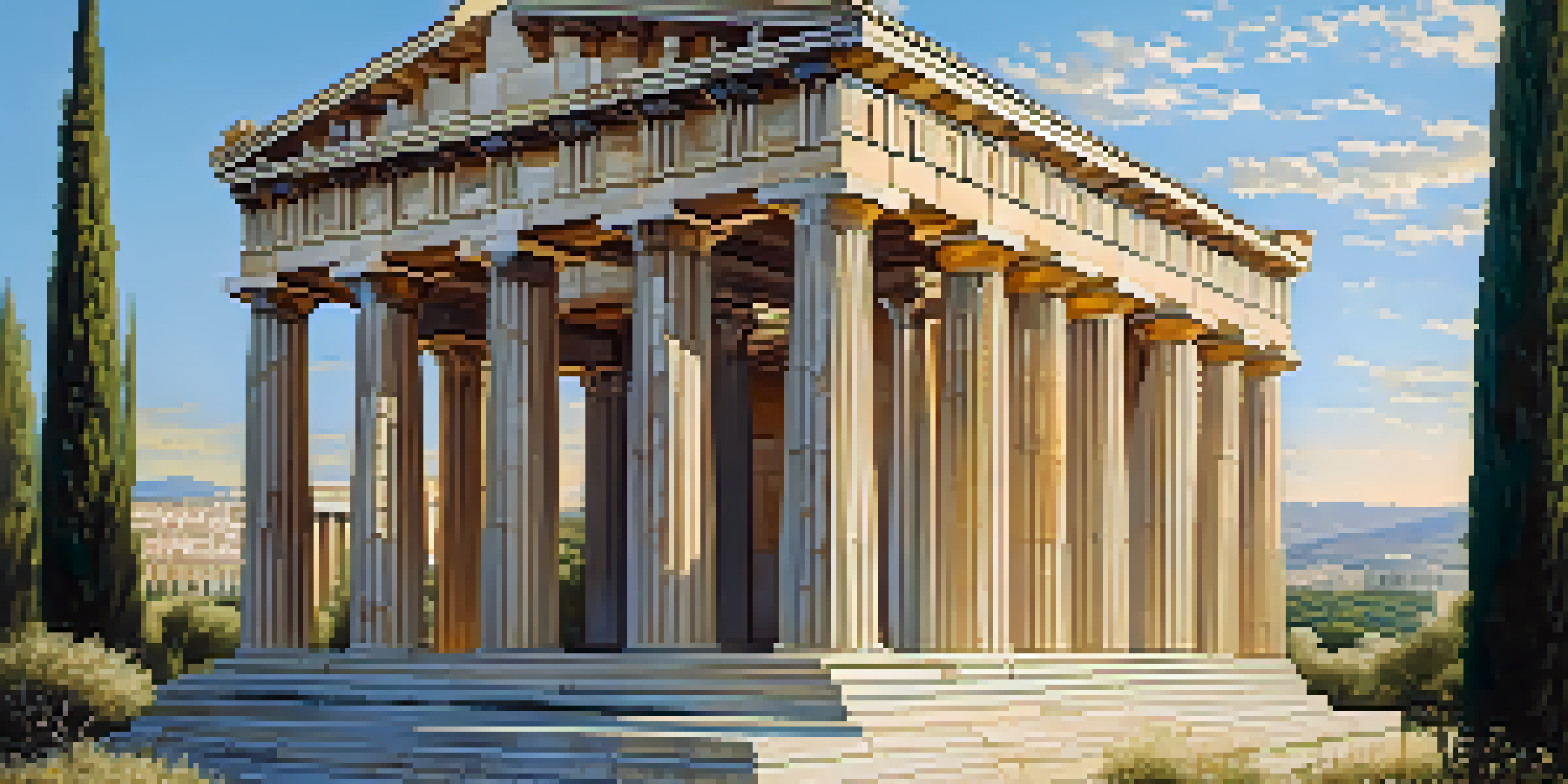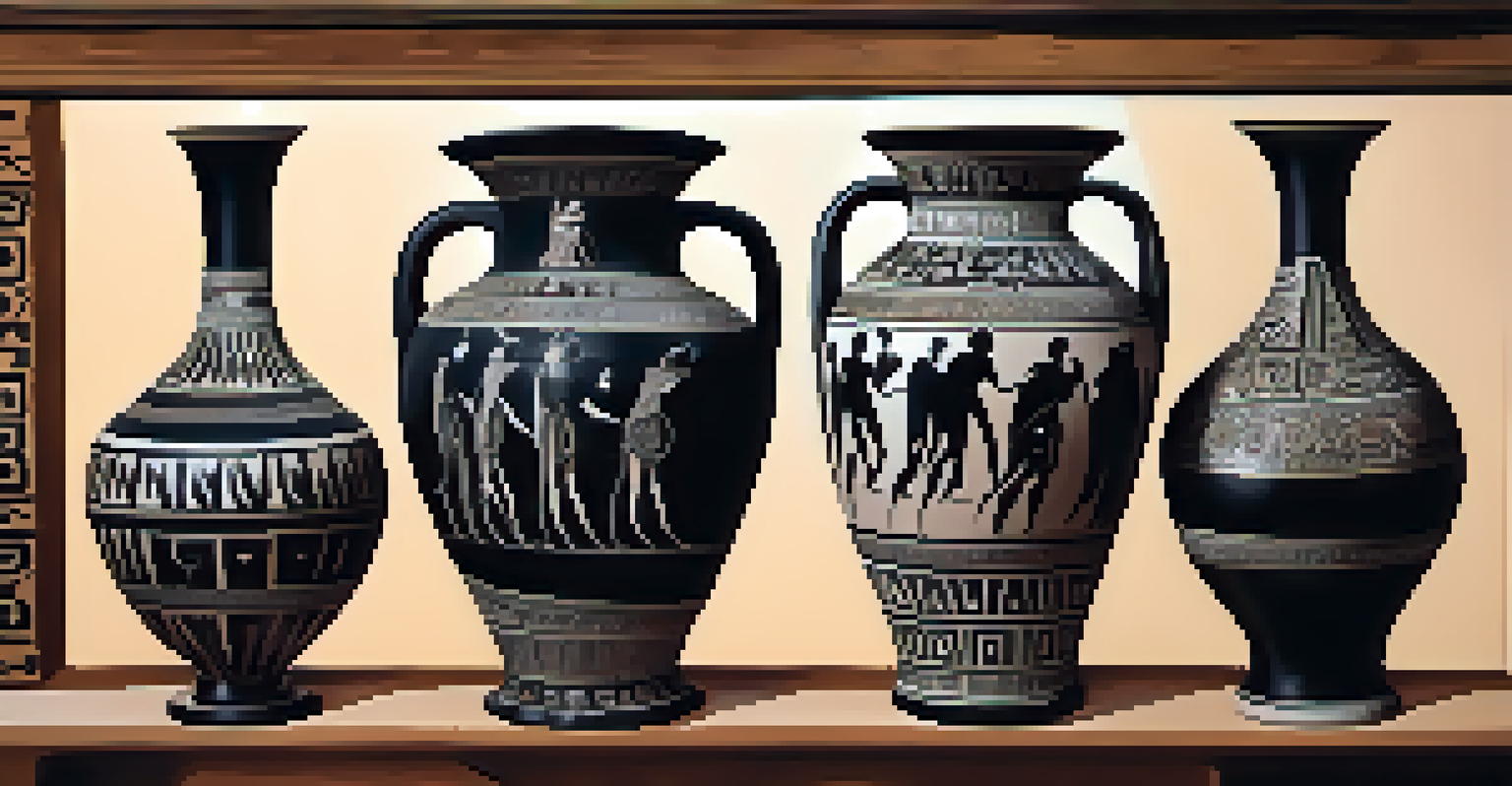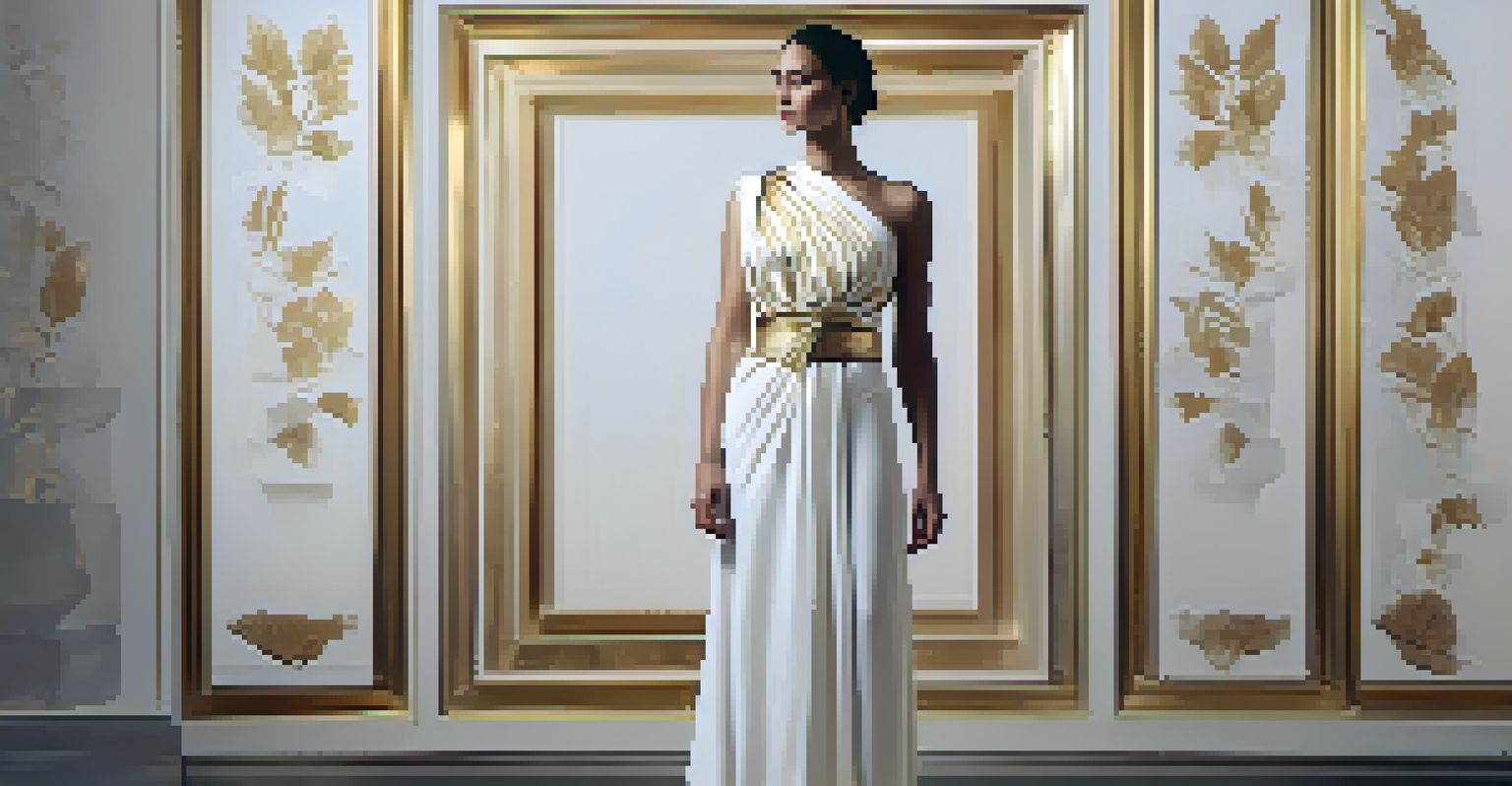The Influence of Ancient Greek Art on Modern Culture

The Foundations of Ancient Greek Art and Its Characteristics
Ancient Greek art, flourishing from around 800 BC to 30 BC, laid the groundwork for many artistic movements that followed. Characterized by its emphasis on symmetry, proportion, and the human form, Greek art sought to depict beauty in a realistic way. Artists used techniques like contrapposto in sculpture, which created a more dynamic representation of the human body.
Art is the most beautiful of all lies.
This focus on realism and idealism meant that Greek artists aimed to capture not just physical appearances but also the essence of their subjects. For instance, the famous sculptures of the Parthenon exemplify these principles, showcasing both intricate detail and a sense of harmony. Such qualities resonate in various modern art forms, highlighting Greek art's lasting influence.
Moreover, the exploration of themes such as mythology and the human experience in Greek art continues to inspire contemporary artists. By examining these ancient works, we see the roots of our current artistic expressions, reminding us that the pursuit of beauty and truth is timeless.
Architecture: The Lasting Legacy of Greek Design
When we think of ancient Greek architecture, iconic structures like the Parthenon come to mind. These buildings utilized columns and open spaces to create a sense of order and beauty that continues to influence modern architecture. The use of the Doric, Ionic, and Corinthian columns can be seen in many public buildings today, reflecting a desire to convey strength and elegance.

Additionally, the principles of symmetry and proportion established by Greek architects have become foundational elements in architectural design. Modern architects often reference Greek styles to evoke a sense of tradition and permanence in their work. The clean lines and balanced proportions of neoclassical buildings, for instance, echo the ancient Greek ethos.
Greek Art Influences Modern Design
Ancient Greek art's emphasis on beauty and realism continues to inspire contemporary artists and designers across various fields.
Furthermore, the concept of public spaces, such as agoras and theaters in ancient Greece, has shaped the design of communal areas in contemporary cities. These spaces foster social interaction, much like their ancient predecessors, illustrating how Greek architecture continues to be relevant in our modern landscape.
The Role of Mythology in Greek Art and Modern Storytelling
Ancient Greek art is deeply intertwined with mythology, featuring gods, heroes, and legendary tales that continue to captivate audiences. Artists often depicted these stories in their works, conveying moral lessons and cultural values. This rich tapestry of narratives has not only influenced visual arts but also modern storytelling in literature, film, and theater.
The greatest wealth is to live content with little, for there is never want where the mind is satisfied.
Today, mythical themes are prevalent in popular culture, from superhero movies to fantasy novels. The archetypes established in Greek myths, such as the hero's journey, resonate in contemporary narratives, highlighting timeless human struggles and triumphs. For example, films like 'Wonder Woman' draw directly from Greek mythology, showcasing the enduring power of these ancient stories.
Moreover, the artistic techniques used to represent these myths, such as dramatic composition and emotional expression, continue to inform modern storytelling. By studying Greek art, creators today find inspiration in how these ancient narratives were visually communicated, ensuring that the legacy of Greek mythology remains vibrant in our cultural consciousness.
Sculpture: From Classical to Contemporary Art Forms
The evolution of sculpture from ancient Greece to modern times is a fascinating journey. Greek sculptors like Phidias and Praxiteles mastered the art of depicting human figures with incredible realism and emotion. This attention to detail and the pursuit of idealized beauty laid the groundwork for future sculptors, inspiring movements such as the Renaissance.
In contemporary art, we see a variety of styles and materials, yet the influence of Greek sculpture is undeniable. Artists like Alberto Giacometti and Henry Moore have drawn on Greek aesthetics, exploring form, balance, and the human condition. The way these artists interpret the human experience echoes the techniques and themes established by their ancient predecessors.
Mythology Shapes Modern Storytelling
The rich narratives of Greek mythology inform and resonate within today's literature, film, and theater, highlighting universal human experiences.
Additionally, public sculptures today often reference Greek ideals, providing a sense of continuity in our artistic heritage. From monuments to installations, the human form and the exploration of space remain central to contemporary sculpture, showcasing the lasting impact of ancient Greek art.
The Influence of Greek Pottery on Modern Design
Ancient Greek pottery is not only functional but also a significant artistic expression that has influenced modern design. The intricate designs and scenes depicted on vases and amphorae serve as a visual history of Greek culture, showcasing everything from daily life to mythological events. These artistic elements have inspired contemporary ceramics and decorative arts.
Today, we see a revival of Greek-inspired motifs in pottery and design, with patterns reminiscent of ancient black-figure and red-figure techniques. Modern ceramicists often incorporate these designs into their work, blending tradition with innovation. This bridge between past and present allows us to appreciate the craftsmanship and creativity of both ancient and contemporary artisans.
Furthermore, the storytelling aspect of Greek pottery, where images convey narratives, resonates with current design philosophies. Just as ancient potters used their craft to tell stories, modern designers use their creations to convey messages and emotions, illustrating the timeless connection between art and life.
The Revival of Classical Themes in Modern Fashion
Fashion is another realm where the influence of ancient Greek art is vividly apparent. Designers often draw inspiration from the flowing lines and draped fabrics characteristic of Greek garments, such as togas and chitons. This revival of classical themes adds an element of elegance and history to modern fashion, appealing to our desire for connection with the past.
Iconic fashion houses frequently reference Greek motifs in their collections, using intricate patterns and silhouettes that evoke a sense of timelessness. For example, the use of gold embellishments and laurel motifs can be traced back to ancient Greece, symbolizing victory and achievement. These elements not only enhance the aesthetic but also imbue garments with cultural significance.
Philosophy and Art Interconnected
The philosophical ideas of ancient Greece regarding beauty and ethics have laid a foundation for ongoing discussions in modern art and culture.
Moreover, the celebration of the human form in Greek art translates into modern fashion's emphasis on body positivity and diversity. By embracing the ideals of beauty from ancient Greece, contemporary designers encourage a broader and more inclusive representation of beauty in their collections, demonstrating that the influence of Greek art extends beyond mere aesthetics.
The Enduring Impact of Greek Art on Modern Philosophy and Thought
Ancient Greek art is not just about visuals; it embodies the philosophical ideas of its time. Thinkers like Plato and Aristotle explored concepts of beauty, ethics, and aesthetics, which have shaped Western thought. These philosophical underpinnings continue to influence modern discussions around art, culture, and morality.
Today, we often reflect on the questions posed by these ancient philosophers, considering what constitutes beauty and how art affects our understanding of the world. The dialogues initiated by Greek thinkers encourage contemporary audiences to engage critically with art and its implications, fostering a deeper appreciation for creativity.

Furthermore, the integration of art and philosophy in ancient Greece has paved the way for interdisciplinary approaches in modern education and culture. By recognizing the interconnectedness of art and thought, we can cultivate a richer understanding of both, ensuring that the legacy of ancient Greek art continues to inspire and provoke thought in today's society.